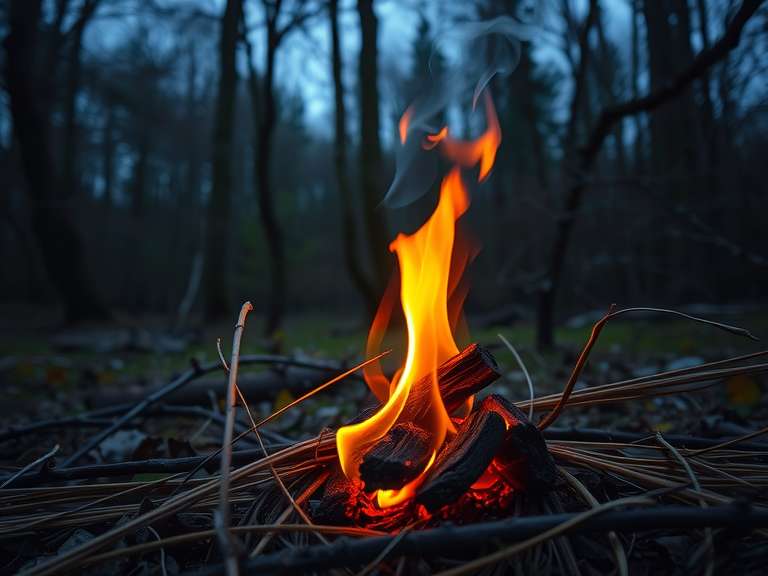When you find yourself in an unexpected situation without your usual fire-starting tools, knowing how to use a battery as a lighter can be a game changer! 🔥 This practical skill can help you ignite a fire quickly and efficiently, making it essential for camping trips, outdoor adventures, or emergency scenarios. In this article, we will explore the key materials you’ll need, the steps to create a spark, and the safety precautions you must follow to ensure a successful fire-starting experience.
Additionally, we will discuss how natural fire starters can enhance your fire-starting efforts, providing quick and reliable ignition. With the right knowledge, you can be better prepared for your next outdoor outing or any unforeseen circumstances that require a reliable fire source.
What Materials Do You Need to Use a Battery as a Lighter?
Using a battery as an improvised lighter is a handy skill, especially in emergency situations. Here’s what you’ll need to create a spark and ignite a fire:
- Battery Selection: A 9V battery is ideal for this method due to its compact size and dual terminals, which are necessary for creating a circuit. Ensure the battery is fully charged to maximize its effectiveness.
- Conductive Material: Steel wool is a popular choice because of its fine strands that easily catch fire when heated. Alternatively, a gum wrapper with a metallic coating can also work, as it conducts electricity and heats up quickly.
- Connection Process: Connect the battery’s terminals to the conductive material. This action causes the material to heat up and ignite, producing a spark that can be used to light tinder or kindling.
| Material | Pros | Cons |
|---|---|---|
| 9V Battery | Compact, efficient, easy to carry | Limited lifespan, potential safety hazards |
| Steel Wool | Highly flammable, quick to ignite | Can be messy, may require careful handling |
| Metallic Gum Wrapper | Versatile, readily available | Less effective if damaged or wet |
Using a battery as a lighter is a viable emergency method, but it’s crucial to consider more reliable options for regular use. Natural fire starters, such as wax-infused cubes and pine rolls, provide consistent ignition solutions that are waterproof and odorless, burning for about 8–10 minutes. They are perfect for various applications, including grilling and lighting fires in adverse weather conditions. To explore more fire-starting methods, understanding the best way to start a fire without a lighter can provide valuable insights. 🔥
How to Create a Spark Using a Battery?
Creating a spark with a battery is a practical skill, especially when traditional fire-starting tools are unavailable. Here’s a step-by-step guide:
- Gather Your Materials: You’ll need a 9V battery and extra-fine steel wool (grade #000). These materials are essential for generating the necessary spark.
- Prepare the Fire Starting Area: Place the steel wool on a flat, non-flammable surface. Arrange kindling and firewood around the steel wool, ensuring a clear area free of flammable materials to prevent unintended fires.
- Generate the Spark: Touch the terminals of the 9V battery to the steel wool. The electrical current will heat the steel wool, causing it to ignite. Once the steel wool is burning, use it to ignite the surrounding kindling.
Common Mistakes to Avoid When Using a Battery as a Lighter
- 🚫 Not checking the battery voltage: A low battery may not produce enough spark.
- 🚫 Using coarse steel wool: Coarse strands may not ignite easily, making it less effective.
- 🚫 Ignoring safety protocols: Failing to follow safety procedures can result in burns or fires.
These steps can be effective in emergencies. However, integrating natural fire starters into your routine can provide further assurance. To learn more about fire-starting methods, consider understanding the challenges of using green or wet wood. 🔥
How Do Natural Fire Starters Enhance Your Fire Starting Efforts?
Natural fire starters, like wax-infused cubes and pine rolls, offer unique advantages that make them standout options for igniting fires quickly. Here’s how they enhance fire-starting efforts:
- Quick Ignition: These fire starters ignite almost instantly, which is imperative when time is limited. This rapid ignition is particularly useful for those engaging in outdoor activities.
- Even Burn: With a stable burning duration of 8–10 minutes, these starters support the ignition of larger fuel sources and help maintain consistent fire conditions.
- Weatherproof Features: Built to withstand various environmental conditions, these fire starters remain effective in rain or wind, making them reliable options.
- Eco-Friendliness: Sourced from natural materials, these fire starters are free from harsh chemicals, offering a sustainable choice for fire-starting needs.
In addition, their odorless nature ensures no unpleasant smells, allowing for a pleasant experience when cooking or enjoying a campfire. For more insights on natural fire starters, explore how to start a fire for beginners. 🔥
What Safety Precautions Should You Follow When Using a Battery?
Using a battery as a lighter can be practical in emergencies, but it carries inherent safety risks. Here are essential precautions to ensure your safety:
- Avoid Short Circuits: Ensure that the battery’s positive and negative terminals do not come into contact with conductive materials. This can lead to overheating or even explosion.
- Handle with Care: Do not crush, puncture, or expose the battery to physical shocks, which could result in hazardous reactions.
- Use Appropriate Equipment: Only utilize chargers and cables suited for your battery and device to prevent overheating.
- Monitor Charging: Avoid charging devices overnight or leaving them unattended to minimize fire risks.
- Store Properly: Keep batteries cool and dry, away from sunlight and heat sources.
- Inspect Regularly: Check batteries for damage before use and dispose of damaged units safely.
- Minimize Metal Contact: Avoid carrying or storing batteries with metal items to prevent accidental short-circuiting.
- Wear Protective Gear: When handling batteries, consider using safety goggles and gloves to mitigate hazards.
- Charge on Non-Conductive Surfaces: This reduces fire risks during charging.
- Proper Disposal: Lithium-ion batteries should not be discarded with regular garbage; recycle them at designated facilities.
| Safety Precautions | Reason |
|---|---|
| Avoid Short Circuits | Prevents overheating and potential explosions. |
| Handle with Care | Avoid injury and hazardous spills. |
| Use Appropriate Equipment | Reduces fire risks from overcharging. |
| Store Properly | Maintains battery integrity and prevents thermal runaway. |
Given these risks, it’s wise to use purpose-built fire-starting tools whenever possible. Natural fire starters, such as wax-infused cubes and pine rolls, are safer alternatives. Their efficiency in various conditions allows for reliable outdoor experiences. For those interested in exploring different fire-starting techniques, learning about how to light a fire in challenging conditions, like the wind, may offer you additional insights. 🔥
When Should You Consider Using a Battery as a Lighter?
Certain situations make using a battery as an improvised lighter a practical solution. Here are scenarios where this method may be particularly valuable:
- Emergency Situations: When caught without matches or a lighter, a battery can act as an improvised ignition source. Techniques using it can provide crucial fire-starting options in emergencies.
- Outdoor Adventures: During camping or hiking, unforeseen weather conditions can turn traditional methods ineffective. A battery and conductive material can be a reliable option for starting a fire.
- Survival Scenarios: In survival situations, the ability to start a fire is vital. Knowing how to use a battery for ignition can be an essential skill when regular methods fail.
Even as an emergency method, it’s important to explore better options. Understanding various fire-starting techniques can broaden your skills. This includes considering the type of starter most suited to your particular environment or activity, such as dry conditions versus moist environments. For instance, understanding which fire starter is the strongest can offer valuable insights. 🔥
🎒 Essential Tools for Reliable Ignition
When embarking on your next outdoor adventure or preparing for emergencies, having the right tools can make a significant difference. Here’s a concise comparison of various fire-starting methods and their effectiveness:
| Tool/Method | Effectiveness | Best Use Cases |
|---|---|---|
| 9V Battery & Steel Wool | High, but dependent on user experience | Emergency scenarios, camping |
| Matches | Very High, user-friendly | General use, reliable for various conditions |
| Lighter | Very High, convenient | Everyday use, camping |
| Natural Fire Starters | High, consistent ignition | Outdoor cooking, weather-resistant options |
| Tinder and Kindling | Moderate, requires dry conditions | Fireplace use, controlled environments |
This comparison can help you determine which method works best for your specific needs and conditions. Packing a variety of fire-starting tools not only prepares you for emergencies but also enhances the overall experience of outdoor activities.





